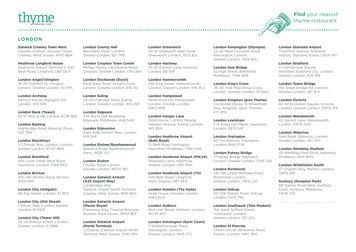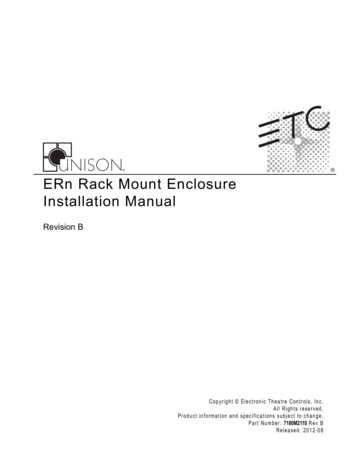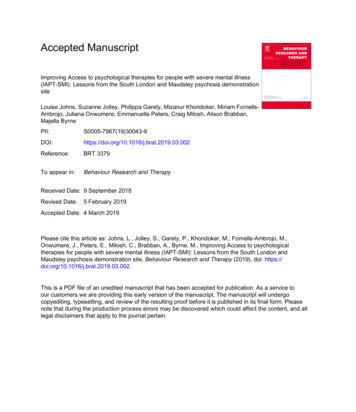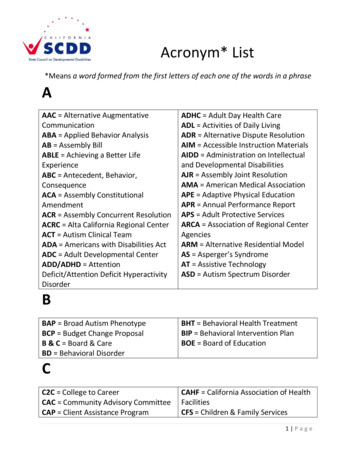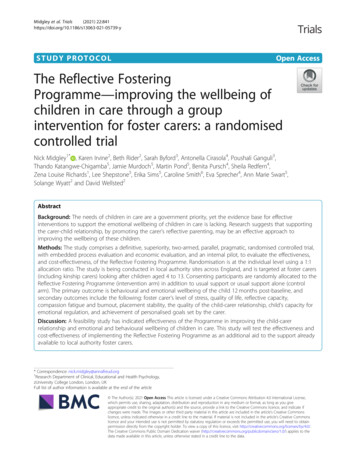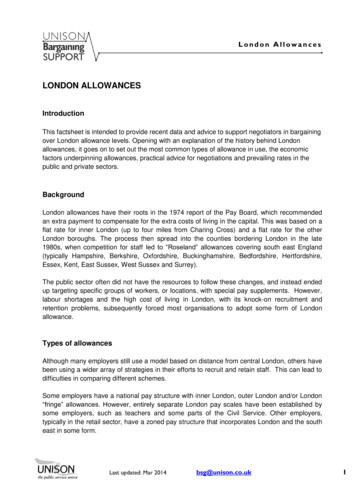
Transcription
London AllowancesLONDON ALLOWANCESIntroductionThis factsheet is intended to provide recent data and advice to support negotiators in bargainingover London allowance levels. Opening with an explanation of the history behind Londonallowances, it goes on to set out the most common types of allowance in use, the economicfactors underpinning allowances, practical advice for negotiations and prevailing rates in thepublic and private sectors.BackgroundLondon allowances have their roots in the 1974 report of the Pay Board, which recommendedan extra payment to compensate for the extra costs of living in the capital. This was based on aflat rate for inner London (up to four miles from Charing Cross) and a flat rate for the otherLondon boroughs. The process then spread into the counties bordering London in the late1980s, when competition for staff led to “Roseland” allowances covering south east England(typically Hampshire, Berkshire, Oxfordshire, Buckinghamshire, Bedfordshire, Hertfordshire,Essex, Kent, East Sussex, West Sussex and Surrey).The public sector often did not have the resources to follow these changes, and instead endedup targeting specific groups of workers, or locations, with special pay supplements. However,labour shortages and the high cost of living in London, with its knock-on recruitment andretention problems, subsequently forced most organisations to adopt some form of Londonallowance.Types of allowancesAlthough many employers still use a model based on distance from central London, others havebeen using a wider array of strategies in their efforts to recruit and retain staff. This can lead todifficulties in comparing different schemes.Some employers have a national pay structure with inner London, outer London and/or London“fringe” allowances. However, entirely separate London pay scales have been established bysome employers, such as teachers and some parts of the Civil Service. Other employers,typically in the retail sector, have a zoned pay structure that incorporates London and the southeast in some form.Last updated: Mar 2014bsg@unison.co.uk1
London AllowancesA 2012 survey of London employers by the Industrial Relations Service (IRS) found that 51% ofemployers pay a specific London allowance, while a further 44% have higher basic rates orsalary scales for employees working in the capital. The remainder did not have eitherarrangement, while some employers deployed both a London allowance and higher pay scales.The survey went on to establish that almost three-quarters of employers pay a Londonallowance that incorporates an entitlement into the contract of employment without any caveats.However, the remaining 26% have a clause permitting payments to be varied at managementdiscretion. These clauses allow employers more leeway in ceasing location payments, shiftingsites from one pay band or zone to another or revising the value of the allowances.Differentials between London and UK ratesThe single biggest element in the extra cost of living in the capital is housing. In January 2014,Land Registry figures showed average house prices across the whole of England and Waleswere 168,536, but in London the average was 409,881 (143% higher than the England/Walesrate). This house price gap has been growing ever larger, with London experiencing 10.9%growth over the last year, compared to 4.2% across England and Wales.1The same picture is apparent in the private rental sector, with the the England rental raterunnings at 665 a month in January 2014, compared to 1,516 a month in London (128%higher than the England rate)2. The differential in local authority rented property is lessexaggerated but still significant, with average rent across England running at 79 a week in2012/13, compared to 99 in London (25% higher than the England average)3.In general, these differences in housing costs are not in line with the difference in averageweekly earnings. The 2013 Annual Survey of Hours and Earnings put the average gross weeklywage in London at 571, compared to 416 across the UK. Therefore, average earnings arearound 37% higher in London, but this is principally due to the different composition of theLondon labour market. The average is driven up by the far higher proportion of relatively highlypaid professional and senior management employees within the London workforce.The differential for similar jobs is probably reflected more accurately by a 2012 XpertHR surveywhich asked London employers by how much their pay rates exceeded their main nationalscales. The results revealed that 55% reported that they are between 1% and 10% higher, 40%are paying between 11% and 20% higher, while 4% are paying in excess of 20%.1House Price Index, Land Registry, January 2014Gumtree Listings, January 20143Local Authority Average Weekly Rents, Table 702, Department of Communities & Local Government, Dec 132Last updated: Mar 2014bsg@unison.co.uk2
London AllowancesAllowance levelsA survey by Incomes Data Services of 95 organisations found that the average Londonallowance payments in 2013/14 were as per the table below.Organisation typeAll organisationsEnergy & waterManufacturing &primaryPublicFinanceNot for profitPrivate servicesRetailCentral / InnerLondon 3,561 5,100 4,100Intermediate /Outer London 2,000 4,285 2,165Outer London /Fringe 1,060 2,700 1,380Fringe / SouthEast 770 4,098 3,948 3,285 3,154 2,055 2,756 2,500 1,746 1,800 1,384 1049 1,636 805 1,140 1,038 1,000 825 555 770 509The 2012 XpertHR allowance survey found that two thirds of public sector London allowancessaw no increase between 2011 and 2012, but of those that did see an uplift, the increaseranged from 0.5% to 4.9%. In contrast, 60% of private sector employers did provide an uplift,which ranged from 2% to 8.9%. In addition, the survey revealed that just over half of employersmake allowances pensionable.IDS has also reported that there has been a trend toward simplifying allowance arrangementsamong many organisations, along with narrowing of the gap between outer and innderalooeances , perhaps in recognition of the high costs across London.Negotiating adviceThe case for improvement in allowance rates can build on the growing housing cost differentialsset out above. However, it is also worth emphasising the following parts i negotiating the detailsof a scheme. Allowances should be paid to all workers. Favouring one group of staff over anothercreates division and inequality. A single London allowance is preferable to inner/outer London allowances. Costs,particularly for housing, are no longer significantly different between inner and outerLondon.Last updated: Mar 2014bsg@unison.co.uk3
London Allowances A flat rate is better than a percentage of salary or allowances targeted at particulargroups. All workers face significantly increased costs in London, and a percentage of alarge salary is much more than a percentage of a small salary. set The precedent of an“across the board payment” and a formula based on the increased costs of living inLondon goes right back to the 1974 Pay Board report. Generally, a specific allowance is preferable to more points on a pay scale or separateLondon grades. These do not give a transparent picture of pay (vital for ensuring equalpay for equal work) and can distort grading structures. Seek to avoid contracts that allow employers leeway in ceasing location payments,shifting sites from one pay band or zone to another or revising the value of theallowances. “Fair employment” clauses for outsourced workers can help to ensure all public serviceworkers benefit from improved allowance payments.Examples of London AllowancesAs benchmarks for negotiating London Allowances, the following tables set out prevailingallowances across the main public sector bodies where UNISON’s membership is concentrated,along with other public sector bodies, not-for-profit organisations and private companies.National Health ServiceOrganisationNHS Agenda forChangeEffectiveDate01/04/13High Cost Area SupplementsInner LondonOuter LondonLondon Fringe20% salary (minimum 4,076 to maximum 6,279)15% salary (minimum 3,448 to maximum 4,351)5% salary (minimum 942 to maximum 1,632)Local GovernmentFor NJC conditioned local authority staff, as part of the London Agreement in 2000, the London WeightingAllowance was incorporated into the GLPC London pay spine. At the time, the London Allowance was 2,556 for Inner London, 1,869 for Outer London scale points 4-10 and 1,359 for Outer London scalepoints 11 and above. The London pay spine has since been increased by the national pay settlement. LocalGovernment Employers (LGE) publish advisory rates for organisations that are not bound by NJC but oftenlink pay to NJC rates. The latest advisory notice by the LGE gave Inner London Allowance at 3,332 andOuter London Allowance at 1,773.Last updated: Mar 2014bsg@unison.co.uk4
London AllowancesEducationOrganisationEffectiveDateInner LondonOuter LondonLondon FringeFurther Education(Lecturers)01/08/13 2,966 1,945 766Sixth Form Colleges(Teachers & SupportStaff)01/09/13 3,652 2,434 964Teachers (England &Wales)01/09/13Differential betweenLondon and nationalscales - 5,466 to 8,326Differential betweenLondon and nationalscales - 3,564 to 3,677Differential betweenLondon and nationalscales - 1,048 to 1,049 3,357 2,756The Association of Colleges (AoC) no longer sets London allowances, these figures arebased on applying to allowances the same percentage increase as the AoC recommendedincreases to basic salaryUniversities (New) &Colleges of HigherEducationAllowances can vary between institutions, so the figuresabove are medians of allowances paidUniversities (Old) 2,323 2,150Allowances can vary between institutions, so the figuresabove are medians of allowances paidPolice & Probation ServiceOrganisationEffectiveDateSingle London ratePolice officers01/07/13London weighting - 2,30101/09/10London allowance - 4,33804/01/13 3,889OrganisationEffectiveDateInner LondonOuter LondonDepartment forWorks and Pensions01/07/13Differential betweenLondon and nationalscales 3,730 to 5,330Differential betweenLondon and nationalscales 2,580 to 4,390HM Revenue &Customs01/06/11Differential betweenLondon and nationalscales 3,840 to 6,884Fire Service01/07/12Single London rate - 5,160Probation ServiceOther Public SectorLast updated: Mar 2014bsg@unison.co.ukLondon Fringe5
London AllowancesCommunity and VoluntaryOrganisationEffectiveDateAdvance Housing er LondonOuter LondonLondon Fringe 1,483 1,051 3,354 1,785 811- 56501/04/12 3,230 1,712 532NSPCC01/01/10 3,300 1,755 798- 555Oxfam01/08/13 3,285 2,215Turning Point01/04/09 3,561 1,689 708London FringeUtilities & EnvironmentOrganisationEffectiveDateInner LondonOuter LondonEnvironment Agency01/07/09 3,372 1,672National Grid01/07/12Single London rate - 4,210British Gas Services01/04/13 5,461Sellafield (formerlyBritish NuclearFuels)01/04/13Single London rate - 5,100OrganisationEffectiveDateInner LondonOuter LondonAviva01/04/01 3,710 1,725Barclays Bank01/10/04 3,550 2,550BBC01/08/13Single London rate - 3,716 for staff earning 25000 and above, 4,288 for staff earning less than 25,000HSBC01/10/04 4,000 3,000Royal Mail Letters(secretarial grades)02/04/12 4,654 3,110Network Rail01/04/09 2,400 1,390 955Santander01/11/10 3,500 2,000 1,000 4,900 - 4,340 1,398 - 699Private SectorLast updated: Mar 2014bsg@unison.co.ukLondon Fringe 1,670 - 750 2,0006
01/04/13 20% salary (minimum 4,076 to maximum 6,279) 15% salary (minimum 3,448 to maximum 4,351) 5% salary (minimum 942 to maximum 1,632) Local Government For NJC conditioned local authority staff, as part of the London Agreement in 2000, the London Weighting Allowance was incorporated into the GLPC London pay spine.
